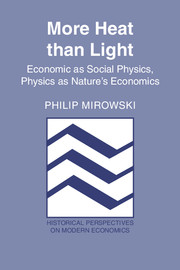Book contents
- Frontmatter
- Contents
- Figures
- Acknowledgments
- 1 The fearful spheres of Pascal and Parmenides
- 2 Everything an economist needs to know about physics but was probably afraid to ask: The history of the energy concept
- 3 Body, motion, and value
- 4 Science and substance theories of value in political economy to 1870
- 5 Neoclassical economic theory: An irresistable field of force meets an immovable object
- 6 The corruption of the field metaphor, and the retrogression to substance theories of value: Neoclassical production theory
- 7 The ironies of physics envy
- 8 Universal history is the story of different intonations given to a handful of metaphors
- Appendix: The mathematics of the Lagrangian and Hamiltonian formalisms
- Notes
- Bibliography
- Index
5 - Neoclassical economic theory: An irresistable field of force meets an immovable object
Published online by Cambridge University Press: 01 June 2011
- Frontmatter
- Contents
- Figures
- Acknowledgments
- 1 The fearful spheres of Pascal and Parmenides
- 2 Everything an economist needs to know about physics but was probably afraid to ask: The history of the energy concept
- 3 Body, motion, and value
- 4 Science and substance theories of value in political economy to 1870
- 5 Neoclassical economic theory: An irresistable field of force meets an immovable object
- 6 The corruption of the field metaphor, and the retrogression to substance theories of value: Neoclassical production theory
- 7 The ironies of physics envy
- 8 Universal history is the story of different intonations given to a handful of metaphors
- Appendix: The mathematics of the Lagrangian and Hamiltonian formalisms
- Notes
- Bibliography
- Index
Summary
I believe that I have succeeded in discovering the force (Kraft), also the law of the effect of this force, that makes possible the coexistence of the human race and that governs inexorably the progress of mankind. And just as the discoveries of Copernicus have made it possible to determine the paths of the planets for any future time, I believe that my discoveries enable me to point out to any man with unfailing certainty the path he must follow in order to accomplish the purpose of his life.
[Hermann Gossen [1853] 1983, p. cxlvii].The truth is, most persons, not excepting professional economists, are satisfied with very hazy notions. How few scholars of the literary and historical type retain from their study of mechanics an adequate notion of force!”
[Irving Fisher [1892] 1926, p. v].Most people with some academic training in economics are aware that the rise of the theory that commands the greatest allegiance in the United States (which we shall call neoclassical economics) was located in the 1870s in several European countries. A little more familiarity with the conventional histories of economic thought will foster the impression that neoclassical theory was “simultaneously discovered” by an Englishman (William Stanley Jevons), a Frenchman (Leon Walras), and an Austrian (Carl Menger), and that after its improvement by a host of others, it eventually displaced all other competing schools of thought in those countries.
- Type
- Chapter
- Information
- More Heat than LightEconomics as Social Physics, Physics as Nature's Economics, pp. 193 - 275Publisher: Cambridge University PressPrint publication year: 1989



